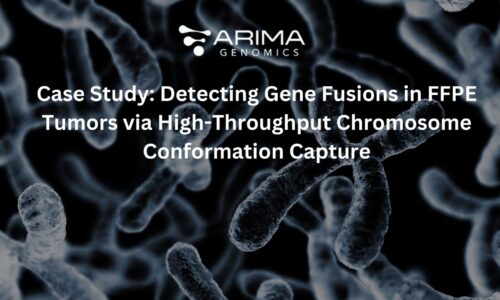August 14, 2024
Share
We are excited to share a new case study featuring work performed by Owen Chapman and colleagues. Extrachromosomal DNA (ecDNA) plays a crucial role in driving tumor growth in medulloblastoma, the most common malignant pediatric brain tumor. This study explores how Arima-HiC+ technology can detect and characterize ecDNA within medulloblastoma tissues, offering valuable insights into its clinical implications. 1, 2
Methodology and Key Findings
This study utilized advanced techniques, including Hi-C sequencing and whole-genome sequencing (WGS), to process clinical medulloblastoma tissue samples. These methods were employed to identify and validate the presence of ecDNA.
The results revealed that ecDNA were detected in 18% of the analyzed cases, with the highest occurrence in the SHH subgroup 1. Moreover, the presence of ecDNA was linked to poorer patient outcomes, including higher rates of relapse and mortality.
This underscores the potential of Arima-HiC+ technology in improving our understanding of cancer biology and informing the development of targeted cancer therapies 1.
Advantages of Arima-HiC+ Technology in ecDNA Detection
- High Sensitivity and Characterization of ecDNA: Arima Hi-C technology provides a sensitive means for detecting ecDNA, offering detailed insights into the 3D genome architecture and mechanisms of oncogene activation.
- Versatility with Clinical Samples including FFPE: The technology is compatible with a variety of sample types, ensuring broad applicability in both clinical and research settings.
- Visual Representation of ecDNA: Arima-HiC+ technology allows for the visual representation of ecDNA and enhancer rewiring events through heat map patterns, offering an intuitive and detailed view of the spatial organization and interaction dynamics of ecDNA.
Arima-HiC+ technology stands out as a powerful tool for the detection and characterization of ecDNA. Its ability to map 3D genome interactions with high resolution and perform robustly with challenging sample types makes it an invaluable asset in cancer research and therapy development. By providing detailed insights into the structural dynamics of ecDNA, this technology supports the advancement of precision medicine in oncology1, 2, 3.
To explore our comprehensive findings and understand how Arima-HiC+ technology can transform cancer research and treatment, we invite you to download the full case study here. Discover the intricate details of ecDNA’s role in medulloblastoma and its promising implications for future therapies.
References:
- Chapman, O.S., et al.(2023) Circular extrachromosomal DNA promotes tumor heterogeneity in high-risk medulloblastoma. Nat Genet 55, 2189–2199.
- Huang Q, Zhang S, Wang G, Han J. (2024) Insight on ecDNA-mediated tumorigenesis and drug resistance. Heliyon. Mar 11;10(6):e27733. doi: 10.1016/j.heliyon.2024.e27733. PMID: 38545177; PMCID:PMC10966608.
- Dong Y, et al. Extrachromosomal DNA (ecDNA) in cancer: mechanisms, functions, and clinical implications. Front Oncol. 2023 Jun 28;13:1194405. doi: 10.3389/fonc.2023.1194405. PMID: 37448518; PMCID: PMC10338009.



